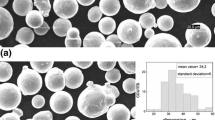Abstract
An investigation of panel crack formation in steel ingots has been undertaken to improve understanding of the mechanisms by which the cracks develop and to evaluate possible solutions to this problem that has plagued the steel industry intermittently for decades. The investigation features the application of two-dimensional, finite-element, heat-flow, and stress models, which have been described in earlier publications1,2 for steel ingot processing. The model predictions have clarified the role of stress generation in panel crack formation and demonstrate the importance of the γ→ α phase transformation. It has been revealed that two distinct types of panel cracks, both of which are partly caused by intermediate-temperature embrittlement of steel involving aluminum nitride precipitation, operate under different mechanisms. Mid-face panel cracks, which are analyzed in Part I of this paper, apparently form during air cooling when the mid-face surface is between the Ar1 and 500 °C. The cracks can be prevented by ensuring the ingot surface does not cool below the Ar1, and preferably the Ar3 temperature. In case of a 335 mm square ingot, this would require reheating and rolling within the first hour after being stripped from the mold. Alternatively charging the ingots to a holding furnace to slow the surface cooling rate through the critical Ar1 – 500 °C temperature zone should be beneficial. Off-corner panel cracks are discussed in Part II.
Similar content being viewed by others
Abbreviations
- Ac1, Ac3 :
-
Austenite to ferrite transformation start and end temperatures on heating (°C)
- Ar3, Ar1 :
-
Austenite to ferrite transformation start and end temperatures on cooling (°C)
- Ae3, Ae1 :
-
Equilibrium transformation temperatures
- t :
-
Time (s)
- T :
-
Temperature (°C)
- TLE :
-
Thermal linear expansion
- x, y :
-
Coordinate directions (m)
- ε:
-
Strain (mm mm−1)
- εp :
-
Plastic-creep function
- εp :
-
Positively accumulated total effective plastic-creep strain (mm mm−1)
- εp :
-
Plastic (and creep) component of strain (mm min−1)
- εT :
-
Thermal component of strain (mm mm−1)
- |σ :
-
Stress (MPa)
- σ:
-
Von Mises effective stress parameter (MPa)
- σ1, σII :
-
Principal stresses (MPa)
- τxy :
-
Shear stress (MPa)
References
B. G. Thomas, I. V. Samarasekera, and J. K. Brimacombe:Metall. Trans. B, 1987, vol. 18B, pp. 119–30.
B. G. Thomas, I. V. Samarasekera, and J. K. Brimacombe:Metall. Trans. B, 1987, vol. 18B, pp. 131–47.
B. L. Biggs:J. Iron Steel Inst., 1959, vol. 197, pp. 361–77.
B. G. Thomas, J. K. Brimacombe, and I. V. Samarasekera:I.S.S. Trans., 1986, vol. 7, pp. 21–29.
B. G. Thomas, J. K. Brimacombe, and I. V. Samarasekera:I.S.S. Trans., 1986, vol. 7, pp. 7–20.
B. G. Thomas, I. V. Samarasekera, and J. K. Brimacombe:Metall. Trans. B, 1984, vol. 15B, pp. 307–18.
P. J. Wray:Modeling of Casting and Welding Processes, H.D. Brody and D. Apelian, eds., TMS, 1980, pp. 245–57.
B. G. Thomas: Ph.D. Thesis, The University of British Columbia, Vancouver, BC, Canada, 1985.
M. Atkins:Atlas of Continuous Cooling Transformation Diagrams for Engineering Steels, British Steel Corporation, Sheffield, 1977.
C. F. ZurLippe and J. D. Grozier:Metal Progress Data Sheet, Feb. 1969.
K. W. Andrews:J. Iron Steel Inst., 1965, vol. 203, p. 721.
O. M. Puhringer:Stahl und Eisen, 1976, vol. 96, no. 6, pp. 279–84.
O. C. Zienkiewicz:Int. J. Numer. Methods in Eng., 1974, vol. 8, pp. 821–45.
B. C. Desai:J. Iron Steel Inst., 1959, vol. 197, pp. 250–56.
K. J. Irvine and F. B. Pickering:Iron and Steel, June 1957, pp. 219–23.
L. Erickson:Scand. J. Metallurgy, 1977, vol. 6, pp. 116–24.
J. F. Guerin and C. M. Roccatagliata:Siderurgia, 1975, vol. 2, no. 6, pp. 91–108.
Hajime Nashiwa, K. Ozaki, M. Yoshihara, and H. Takashima:Tetsu-to-Hagané 1976, vol. 62, no. 4, p. S156. (Translation by Center for Research Libraries No. CRL/T. 7004.)
Author information
Authors and Affiliations
Rights and permissions
About this article
Cite this article
Thomas, B.G., Samarasekera, I.V. & Brimacombe, J.K. Investigation of panel crack formation in steel ingots: Part I. Mathematical analysis and mid face panel cracks. Metall Trans B 19, 277–287 (1988). https://doi.org/10.1007/BF02654213
Received:
Issue Date:
DOI: https://doi.org/10.1007/BF02654213




